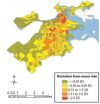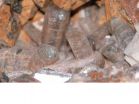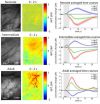(Press-News.org) ANN ARBOR, Mich. — As cities across America work to reduce violence in tight budget times, new research shows how they might be able to target their efforts and police attention – with the help of high-powered computers and loads of data.
In a newly published paper, University of Michigan Medical School researchers and their colleagues have used real police data from Boston to demonstrate the promise of computer models in zeroing in on violent areas.
They combined and analyzed information in small geographic units, on police reports, drug offenses, and alcohol availability at stores, bars and restaurants, as well as the education levels, employment and other attributes of the people who live there.
The result: a detailed map of violent crime "hot spots", and a better understanding of factors that create the right climate for violence. Both could help a city's leaders and police focus resources on the areas where they can do the most good.
The findings, made using funding from the National Institutes of Health, are published online in the American Journal of Public Health.
With the growing availability of data from local, state and federal sources, the team says the approach could be applied to any city or metropolitan area. It can show which micro-environments – down to blocks and intersections -- need most attention.
In fact, they are currently preparing the same analysis for the city of Flint, Mich., which unlike Boston has some of the nation's highest violent crime rates. Victims of that violence often end up in a hospital emergency room staffed by U-M doctors.
"This approach allows us to find predictors of violence that aren't just related to an individual's predisposition -- but rather, allow us to study people in places and a social environment," says Robert Lipton, Ph.D., lead author and an associate professor of emergency medicine at the U-M Medical School.
Lipton, who describes himself as a geographical epidemiologist, and several of his co-authors are members of the U-M Injury Center, which has federal funding to study and test ways to reduce injuries of all kinds.
Researchers have studied the relationship between alcohol availability and violence for years. But the new paper adds several new facets: arrests for drug possession and dealing, and citizen calls to 911 about drug use, as well as the broader geographic factors surrounding each type of establishment where alcohol is sold.
Details from state liquor board licenses, police records and the U.S. Census Bureau all factored into the analysis. Over time, other types of data could be added – so that researchers and police can see the impact of any factor that might contribute to violent behavior.
The goal: to help policy makers and police identify areas that have higher rates of risk factors that may combine to produce violence.
The density of liquor stores or alcohol-serving bars and restaurants alone isn't enough to explain violence patterns – the new paper shows that it's much more complex than that.
"Why are two areas of a city, which seem to be the same across typical demographic factors, different in their level of violence? We need to become more nuanced in understanding these relationships," says Lipton, who is also a member of the Prevention Research Center at the U-M School of Public Health.
The new research, begun when Lipton was at Beth Israel Deaconess Hospital in Boston, involved Anthony Braga, a Harvard University criminologist who is chief policy advisor to the Boston police commissioner, and Massachusetts Institute of Technology economist Xiaowen Yang. Co-authors also include U-M statistician Jason Goldstick, Ph.D., U-M emergency medicine doctor Manya Newton, M.D., MPH, and Injury Center research analyst Melissa Rura, Ph.D.
The analysis of Boston data may help local authorities – while also helping the U-M researchers test their models and theories. Even with Boston's relatively low violent crime rate, the researchers found they could show how place-based factors influence crime rates.
The study examined 2006 data on homicides and aggravated assault incidents, drug arrests and 911 citizen emergency calls from the Boston Police Department along with 2000 U.S. census data and 2009 alcohol outlet data from the Massachusetts Alcohol Beverage Control Commission.
Results from the study indicate that types and densities of alcohol outlets were directly related to violent crimes despite the fact that alcohol outlets are typically viewed as locations in which other population or environmental factors, such as poverty or prostitution, relate to the violence.
The study also shows that drug possession, rather than drug distribution, has a positive relationship with violent crimes. Features of adjacent areas, and activities occurring there, were also found to be significantly related to violent crime in any given "target" area.
INFORMATION:
Reference:
American Journal of Public Health, advance online publication doi: 10.2105/AJPH.2012.300927
The research was supported by grant R21AA18204 from the National Institute on Alcohol Abuse and Alcoholism, one of the National Institutes of Health.
Could a computer on the police beat prevent violence?
Detailed analysis of drugs, alcohol & crimes across a city could help target prevention, U-M study finds
2013-02-19
ELSE PRESS RELEASES FROM THIS DATE:
Russian fireball largest ever detected by CTBTO's infrasound sensors
2013-02-19
Infrasonic waves from the meteor that broke up over Russia's Ural mountains last week were the largest ever recorded by the CTBTO's International Monitoring System. Infrasound is low frequency sound with a range of less than 10 Hz. The blast was detected by 17 infrasound stations in the CTBTO's network, which tracks atomic blasts across the planet. The furthest station to record the sub-audible sound was 15,000km away in Antarctica.
The origin of the low frequency sound waves from the blast was estimated at 03:22 GMT on 15 February 2013. People cannot hear the low frequency ...
Researchers create semiconductor 'nano-shish-kebabs' with potential for 3-D technologies
2013-02-19
Researchers at North Carolina State University have developed a new type of nanoscale structure that resembles a "nano-shish-kebab," consisting of multiple two-dimensional nanosheets that appear to be impaled upon a one-dimensional nanowire. But looks can be deceiving, as the nanowire and nanosheets are actually a single, three-dimensional structure consisting of a single, seamless series of germanium sulfide (GeS) crystals. The structure holds promise for use in the creation of new, three-dimensional (3-D) technologies.
The researchers believe this is the first engineered ...
Theory of crystal formation complete again
2013-02-19
Exactly how a crystal forms from solution is a problem that has occupied scientists for decades. Researchers at Eindhoven University of Technology (TU/e), together with researchers from Germany and the USA, are now presenting the missing piece. This classical theory of crystal formation, which occurs widely in nature and in the chemical industry, was under fire for some years, but is saved now. The team made this breakthrough by detailed study of the crystallization of the mineral calcium phosphate –the major component of our bones. The team published their findings yesterday ...
New study shows how seals sleep with only half their brain at a time
2013-02-19
TORONTO, ON – A new study led by an international team of biologists has identified some of the brain chemicals that allow seals to sleep with half of their brain at a time.
The study was published this month in the Journal of Neuroscience and was headed by scientists at UCLA and the University of Toronto. It identified the chemical cues that allow the seal brain to remain half awake and asleep. Findings from this study may explain the biological mechanisms that enable the brain to remain alert during waking hours and go off-line during sleep.
"Seals do something biologically ...
We know when we're being lazy thinkers
2013-02-19
Are we intellectually lazy? Yes we are, but we do know when we take the easy way out, according to a new study by Wim De Neys and colleagues, from the CNRS in France. Contrary to what psychologists believe, we are aware that we occasionally answer easier questions rather than the more complex ones we were asked, and we are also less confident about our answers when we do. The work is published online in Springer's journal Psychonomic Bulletin & Review.
Research to date on human thinking suggests that our judgment is often biased because we are intellectually lazy, or ...
NYU's Shedlin publishes study on the health of Colombian refugees in Ecuador
2013-02-19
New York University College of Nursing's Professor Michele Shedlin, PhD, recently published a paper, "Sending-Country Violence and Receiving-Country Discrimination: Effects on the Health of Colombian Refugees in Ecuador," on-line in the Journal of Immigrant and Minority Health, February 2, 2013.
Studies of immigrant health have historically focused on individual-level risk factors more than environmental/structural factors as salient mediating variables. Shedlin's research addresses the need to reach a more complete understanding of the migration process and vulnerabilities ...
Study shows that diet of resistant starch helps the body resist colorectal cancer
2013-02-19
As the name suggests, you can't digest resistant starch so it ends up in the bowel in pretty much the same form it entered your mouth. As unlovely as that seems, once in the bowel this resistant starch does some important things, including decreasing bowel pH and transit time, and increasing the production of short-chain fatty acids. These effects promote the growth of good bugs while keeping bad bugs at bay. A University of Colorado Cancer Center review published in this month's issue of the journal Current Opinion in Gastroenterology shows that resistant starch also helps ...
Annals of Internal Medicine tip sheet for Feb. 19, 2013
2013-02-19
1. Acupuncture May be an Effective Alternative for Treating Seasonal Allergies
Patients receiving acupuncture treatments for seasonal allergic rhinitis reported statistically significant improvements in symptoms and decreased use of medication compared to patients having standard treatment or sham acupuncture, but the clinical significance of the observed improvements is uncertain. Allergic rhinitis (stuffy or runny nose caused by allergies) is an extremely common condition that affects approximately 20 percent of the U.S. population. Despite the availability of effective ...
Shedding new light on infant brain development
2013-02-19
New York, NY—February 18, 2013—A new study by Columbia Engineering researchers finds that the infant brain does not control its blood flow in the same way as the adult brain. The paper, which the scientists say could change the way researchers study brain development in infants and children, is published in the February 18 Early Online edition of Proceedings of the National Academy of Sciences (PNAS).
"The control of blood flow in the brain is very important" says Elizabeth Hillman, associate professor of Biomedical Engineering and of Radiology, who led the research study ...
The role of goop: Research shows pollution doesn't change the rate of droplet formation
2013-02-19
When it comes to forming the droplets that make up clouds, a little oily and viscous organic material apparently doesn't matter that much. And that's good news for reducing the uncertainty of climate model predictions.
Understanding cloud formation is essential for accurate climate modeling, and understanding cloud formation begins with the droplets that make up clouds. Droplets form when water vapor is attracted to particles floating in the atmosphere. These particles include dust, sea salt from the ocean, microorganisms, soot, sulfur – and organic material that can ...
LAST 30 PRESS RELEASES:
Why nail-biting, procrastination and other self-sabotaging behaviors are rooted in survival instincts
Regional variations in mechanical properties of porcine leptomeninges
Artificial empathy in therapy and healthcare: advancements in interpersonal interaction technologies
Why some brains switch gears more efficiently than others
UVA’s Jundong Li wins ICDM’S 2025 Tao Li Award for data mining, machine learning
UVA’s low-power, high-performance computer power player Mircea Stan earns National Academy of Inventors fellowship
Not playing by the rules: USU researcher explores filamentous algae dynamics in rivers
Do our body clocks influence our risk of dementia?
Anthropologists offer new evidence of bipedalism in long-debated fossil discovery
Safer receipt paper from wood
Dosage-sensitive genes suggest no whole-genome duplications in ancestral angiosperm
First ancient human herpesvirus genomes document their deep history with humans
Why Some Bacteria Survive Antibiotics and How to Stop Them - New study reveals that bacteria can survive antibiotic treatment through two fundamentally different “shutdown modes”
UCLA study links scar healing to dangerous placenta condition
CHANGE-seq-BE finds off-target changes in the genome from base editors
The Journal of Nuclear Medicine Ahead-of-Print Tip Sheet: January 2, 2026
Delayed or absent first dose of measles, mumps, and rubella vaccination
Trends in US preterm birth rates by household income and race and ethnicity
Study identifies potential biomarker linked to progression and brain inflammation in multiple sclerosis
Many mothers in Norway do not show up for postnatal check-ups
Researchers want to find out why quick clay is so unstable
Superradiant spins show teamwork at the quantum scale
Cleveland Clinic Research links tumor bacteria to immunotherapy resistance in head and neck cancer
First Editorial of 2026: Resisting AI slop
Joint ground- and space-based observations reveal Saturn-mass rogue planet
Inheritable genetic variant offers protection against blood cancer risk and progression
Pigs settled Pacific islands alongside early human voyagers
A Coral reef’s daily pulse reshapes microbes in surrounding waters
EAST Tokamak experiments exceed plasma density limit, offering new approach to fusion ignition
Groundbreaking discovery reveals Africa’s oldest cremation pyre and complex ritual practices
[Press-News.org] Could a computer on the police beat prevent violence?Detailed analysis of drugs, alcohol & crimes across a city could help target prevention, U-M study finds



